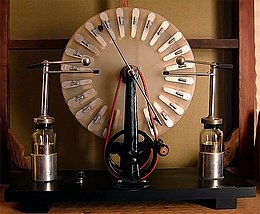Wimshurst machine: Difference between revisions
m copy edits -- much mor eneed to be done |
→Description: copyedit, removal of redundant sentence |
||
| Line 13: | Line 13: | ||
[[Image:Wimshurst_Plasma_Arc.jpg|444px|thumb|center|Wimshurst Machine sparks]] |
[[Image:Wimshurst_Plasma_Arc.jpg|444px|thumb|center|Wimshurst Machine sparks]] |
||
The machine is self-starting, meaning external electrical power is not required to create the initial charge. |
The machine is self-starting, meaning that external electrical power is not required to create the initial charge. It does require mechanical [[power (physics)|power]] however, to turn the disks against the electric field, and it is this energy that the machine converts into electric power. The output of the Wimshurst machine is essentially a constant [[Current (electricity)|current]], that is proportional to the area covered by the metal sectors and the rotation speed. The accumulated spark energy can be increased by adding a pair of [[Leyden jar|Leyden jars]], an early type of [[capacitor]] suitable for high voltages, with the jars’ inner plates independently connected to each of the output terminals and the jars’ outer plates interconnected. A typical Wimshurst machine can produce sparks that are about a third of the disk's diameter in length and several tens of microamperes of current. |
||
== References == |
== References == |
||
Revision as of 03:37, 21 December 2007


The Wimshurst machine is an electrostatic device for generating high voltages developed between 1880 and 1883 by British inventor James Wimshurst (1832 – 1903). It has a distinctive appearance with two large contra-rotating discs mounted in a vertical plane, two cross bars with metallic brushes, and a spark gap formed by two metal spheres.
Description
These machines belong to a class of generators called influence machines, which create electric charges through electrostatic induction, or influence. Earlier machines in this class were developed by Wilhelm Holtz (1865 and 1867), August Toepler (1865), and J. Robert Voss (1880). The older machines, which worked by friction, were less efficient and exhibited an unpredictable tendency to switch their polarity. The Wimshurst did not have this defect.
In a Wimshurst machine, the two insulated disks and their metal sectors rotate in opposite directions passing the crossed metal neutralizer bars and their brushes. An imbalance of charges is induced, amplified, and collected by two pairs of metal combing points placed near the surfaces of each disk. These collectors are mounted on insulating supports and connected to the output terminals. The positive feedback increases the accumulating charges exponentially until the dielectric breakdown voltage of the air is reached and a spark jumps across the gap.
The machine is self-starting, meaning that external electrical power is not required to create the initial charge. It does require mechanical power however, to turn the disks against the electric field, and it is this energy that the machine converts into electric power. The output of the Wimshurst machine is essentially a constant current, that is proportional to the area covered by the metal sectors and the rotation speed. The accumulated spark energy can be increased by adding a pair of Leyden jars, an early type of capacitor suitable for high voltages, with the jars’ inner plates independently connected to each of the output terminals and the jars’ outer plates interconnected. A typical Wimshurst machine can produce sparks that are about a third of the disk's diameter in length and several tens of microamperes of current.
References
- "History of Electrostatic Generators". Hans-Peter Mathematick Technick Algorithmick Linguistick Omnium Gatherum.
- de Queiroz, Antonio Carlos M., "Electrostatic Machines".
- de Queiroz, Antonio Carlos M., "The Wimshurst Electrostatic Machine"
- Weisstein, Eric W., "Wimshurst Machine".
- Bossert, François, "Wimshurst machine". Lycée Louis Couffignal, Strasbourg. (English version)
- Charrier Jacques "La machine de Wimshurst". Faculté des Sciences de Nantes.
